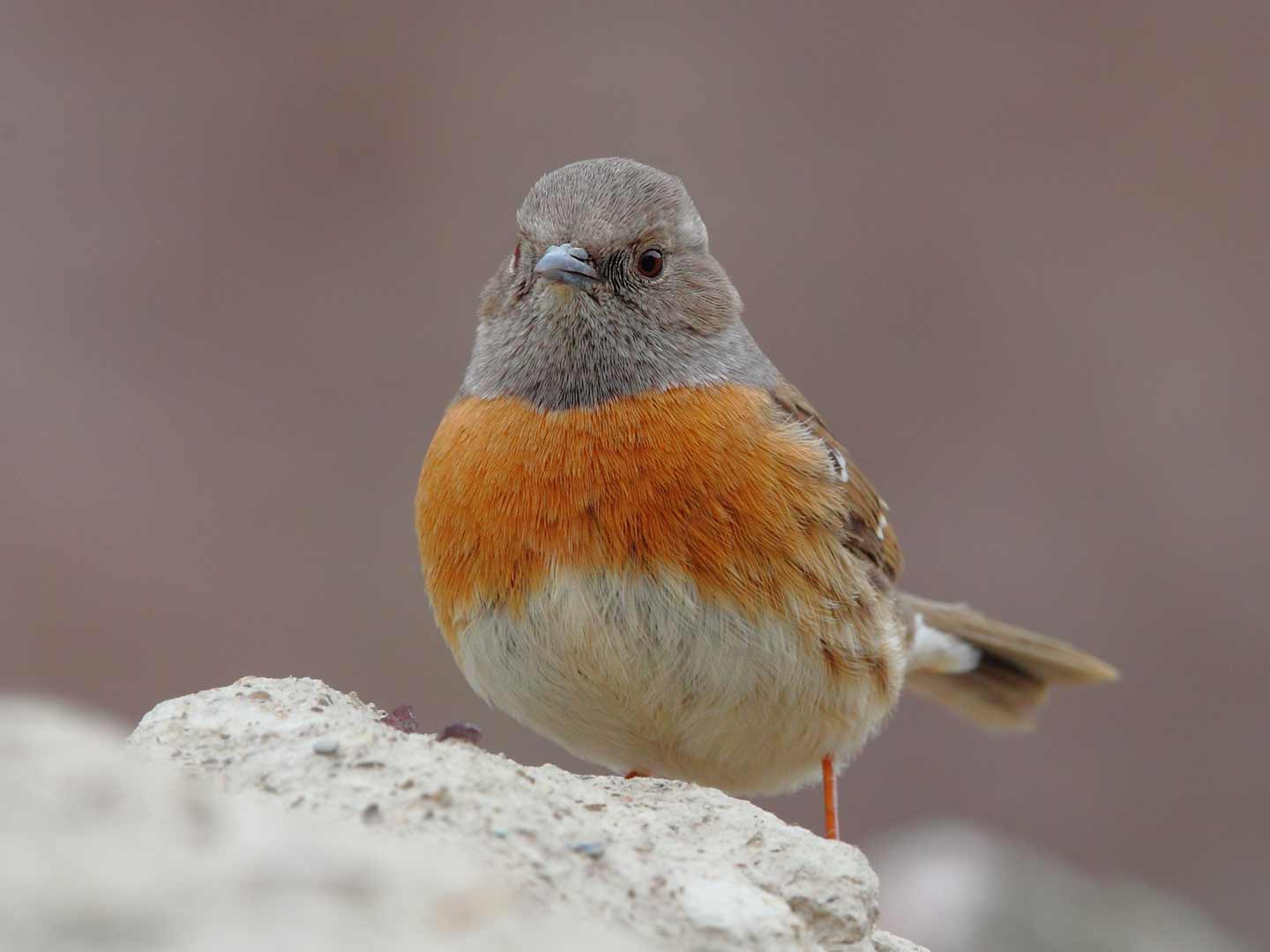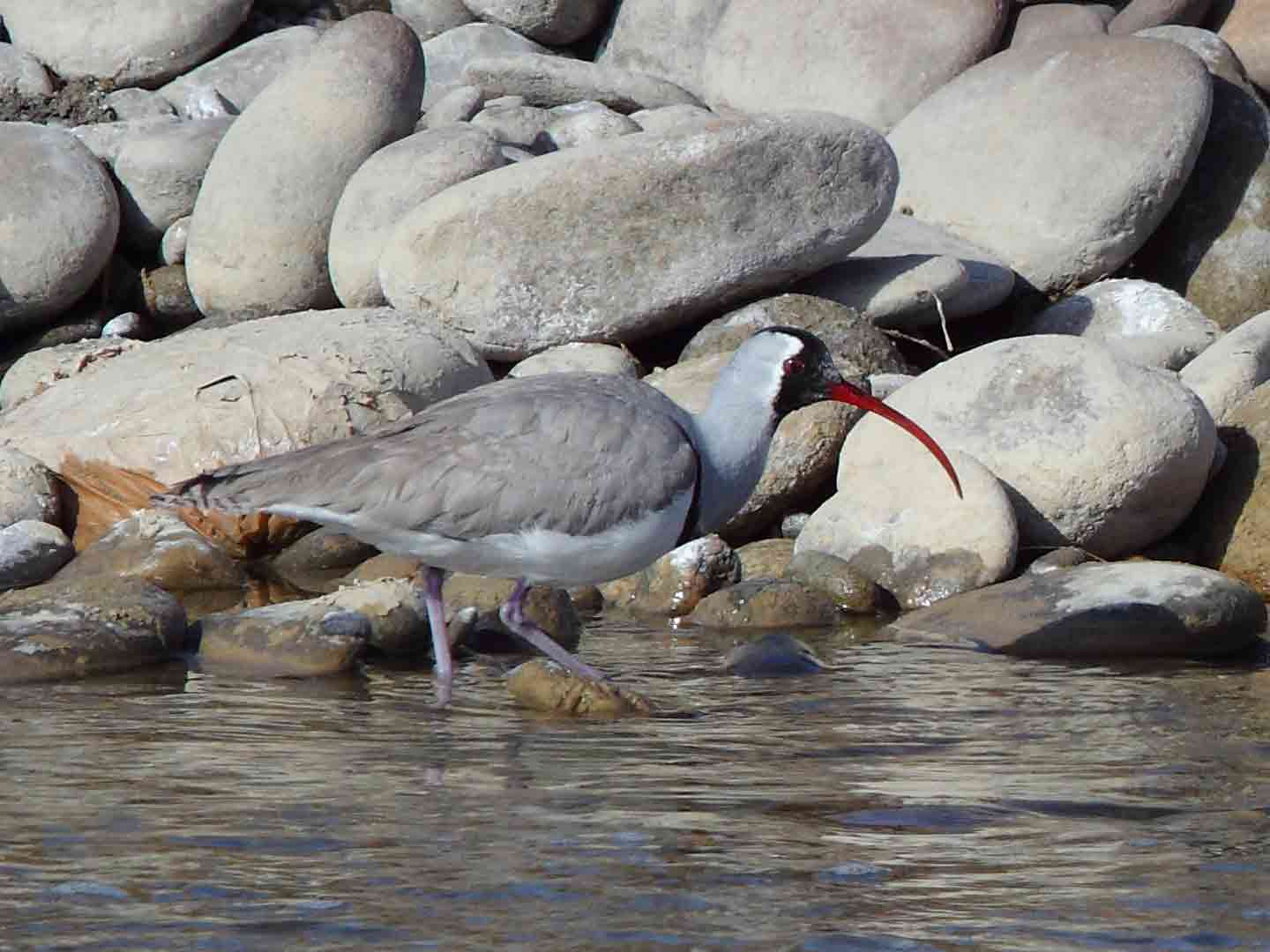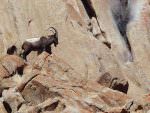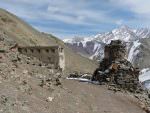Introduction
Your journey begins with an impressive flight over breath-taking snow-clad peaks of the high Himalaya. After acclimatising in Leh you’ll head to Hemis National Park, referred to as the ‘Kingdom of the Snow Leopard’ because sightings of this magnificent cat occur here regularly. Expert guides pick up tracks and signs, contributing observations and knowledge to the conservation of the species and increasing the chance of successful sightings. Other mammals occur too – Tibetan Argali (Great Tibetan Sheep), Ladakh Urial, Asiatic Ibex and, rarely, Tibetan Wolves are seen.
Birds include some of the high altitude specialists. You’ll look for Ibisbill along the mighty Indus, the “Mother of Rivers”, where you may encounter flocks of Guldenstadt’s Redstarts. Brown and Robin Accentors occur and sometimes Red‑fronted Serin. A tour to tempt anyone with an intrepid explorer within them.
There are many ways to extend this tour, so please contact us for details
Itinerary and price
Small Group tour:
Please enquire for 2020 and 2021 dates
Maximum group size: 8 plus guides
Day 1: Flight to be organised by you
For help with your flight arrangements and to receive a no obligation quote, you can complete the enquiry form on our website or call 0800 280 8947 to speak to a flight advisor at StudentUniverse (in partnership with Gapyear.com), part of the Flight Centre Travel Group, a leading retailer of airfares and worldwide flights.
Day 2: Delhi
Meals: Payable directly today
Your flight arrives in Delhi. Here you will be met outside the airport by our representative and taken to check in at Hotel Lohmod (room available from 12 noon). Flights arriving mid/late morning would allow time to visit Sultanpur Bird Sanctuary with your guide in the afternoon, leaving your hotel by 1330 hours at the latest. For later arrivals you can relax at the hotel. Overnight stay at Hotel Lohmod.
Day 3: Delhi – Leh
Meals: Lunch and dinner
It won’t be possible to have breakfast this morning as you’ll need to meet your fellow travellers at 0400 hours at hotel reception to transfer together to the airport in time to check in for your flight (booked by you) with Jet Airways (no. 9W2368) departing at 0630 hours arriving in Leh at 0755 hours. This must be one of the most sensational flights in the world, so book a window seat if possible! On a clear day the peaks of K2, Nanga Parbat and Gasherbrum can be seen in the distance on one side of the aircraft and on the other side, so close that you feel you could reach out and touch it, is the Nun Kun massif.
Upon arrival in Leh you will be transferred to the hotel. You must take a little time to settle in and acclimatise since your journey will have brought you to an altitude of about 3,500m, so complete rest in your hotel is recommended. Later today we will take you to visit the office of Snow Leopard Conservancy in Leh where you can hear about the work of this worthwhile NGO and you can purchase souvenirs, though there is no pressure to do so. Agree a time to meet with your guide the next morning.
Overnight at Hotel Mahey Retreat.
Day 4: Leh
Meals: Breakfast, lunch and dinner
Another full day of taking it easy to acclimatise to the rarefied air is very wise although it will be possible to do some birding to look for Ibisbill, Solitary Snipe, Horned Lark, Guldenstadt‟s (White-winged) Redstart and a few other species local to Leh. For those who wish we can include a visit to Thiksey Monastery where you‟ll enjoy commanding views across the Indus Valley. Your guide will confirm the times to meet up tomorrow morning for the drive to Hemis. Overnight Hotel Mahey Retreat.
Day 5: Leh - Zingchen – Husing (Hemis National Park)
Meals: Breakfast, lunch and dinner
Drive to Zingchen and Hemis National Park - the home of the Snow Leopard. From here we will walk approx. 1½ hrs to the campsite at Husing located at approximately 3700 m. The actual walk is not far and the track isn‟t steep, but for some it will take a bit of effort at this altitude! Husing is a perfect location in a corridor linking three valleys where there is much evidence of Snow Leopard. Your guide will point out scrapes, spray sites and of course the ultimate would be a sighting of this fine cat! After lunch at the camp spend the afternoon looking for Snow Leopards in the Tarbung area, returning to Husing tented camp for the night. This afternoon and the rest of the time in Hemis will remain flexible depending on the sightings of Snow Leopard, so you may move camp or have a night or two at a local homestay in Rumbak or Yurutse (a wonderful experience) when required, but expect most of the time to be in tents.
Days 6 and 7: Zingchen area (Husing Valley and local area at approx. 3700m) trekking at times up to approx. 4600m
Meals: Breakfast, lunch and dinner
The junction of Husing Nala and Tarbung Nala and local high ridges will be scanned, there will be a hike to a vantage point at Rumbak Sumdo and the area of the parachute café to scan for sightings. During this time you should see Chukar, White-winged Redstart, Lammergeier, Golden Eagle, Fire-fronted Serin (depending on dates), Himalayan Snowcock, Yellow-billed and Red-billed Choughs, Robin Accentor, Horned Lark, Tibetan Snowfinch, perhaps Eurasian Eagle Owl and a few other species. Look out for groups of Blue Sheep (Bharal), Mountain Weasel, Red Fox, Stone Marten and among the boulders on warmer days Royle's Pika often venture out. Overnight at Husing tented camp. Note: depending on the tracks and signs of the Snow Leopard you might change camping site - there are up to three likely camping locations. The camp staff will arrange everything for you and your main bags will be transported by pony/mule so you just have to carry your optics and day bag.
Day 8: Husing Valley – Rumbak
Breakfast, lunch and dinner
Depending on sightings and the weather we may move location today to focus on the Rumbak area. The mountains around Rumbak are home to Asiatic Ibex, Ladakh Urial and Tibetan Argali, though these species can prove difficult here and are potentially easier to see at other locations outside of Hemis National Park which will be visited later in the tour. After breakfast, the trek to Rumbak village (again not that far) will take approximately 2 to 3 hours where we may camp or stay in a homestay for the night, or just return to the original camp. Further exploration today may take us to 4600m up towards Yurutse where it is possible to see Tibetan Argali.
Days 9 and 10: Rumbak (4050 - 4450m)
Meals: Breakfast, lunch and dinner
We‟ll continue our quest with more trekking, looking for tracks and signs, scanning the ridges and mountain-sides with telescopes and binoculars. Tibetan Wolf tracks and signs are likely with sightings possible, but more difficult. We will visit Husing Pass (4450 m) and scan from excellent vantage points on the pass. On another day we may hike for 3 - 4 hours towards Gangala base to look for Tibetan Argali in an area where the habitat is also good for Eurasian Lynx, Tibetan Wolf and Tibetan Partridge. Nights will either be in homestays or tented camps.
Day 11: Rumbak - Husing
Meals: Breakfast, lunch and dinner
This morning could be spent around Stok La base and in the afternoon/evening we would move to Kharlung, returning to Husing camp. As previously mentioned, this is subject to sightings and weather, so the programme needs to remain flexible.
Day 12: Husing Camp – Zinchen – Ulley
Meals: Breakfast, lunch and dinner
After seven nights in Hemis National Park we‟ll walk for about an hour down to Zinchen where the vehicles will be waiting to take us to a different location, the area of Ulley or Saspoche, depending on Snow Leopard sightings. The drive will take us back along the Indus river. On the journey look out for Brown Dipper on the steams and the handsome Asiatic Ibex, endemic Ladakh Urial and Tibetan Wolf in the valleys and on the mountain slopes. Night in a local homestay at Saspoche or Ulley.
Day 13: Saspoche / Ulley
Meals: Breakfast, lunch and dinner
Our search for the elusive Snow Leopard will continue around Saspoche/Ulley where the Snow Leopard Conservation estimates there are around 8 to 10 of these cats; you‟ll have a good chance of seeing Asiatic Ibex here, too. Birds locally may include Great Rosefinch, Brown Dipper and White-winged Redstart. Overnight at homestay in Saspoche or Ulley.
Day 14: Saspoche / Ulley - Leh
Meals: Breakfast, lunch and dinner
This morning we will trek down to a location where Ibex are found in large numbers. After a packed or hot lunch we will drive back to Leh. Night at Hotel Mahey Retreat in Leh.
Day 15: Leh - Delhi
Meals: Breakfast
You are likely to have an early start this morning. A transfer is included to the airport for your early morning flight to Delhi (booked by you). Your return flight would be with Jet Airways or Air India – flight number and times to be confirmed. A bird guide will be at Delhi airport to welcome you and take you to Sultanpur National Park to enjoy birdwatching. Your driver will look after your luggage and the guide will accompany you around Sultanpur (his services and entrance fees are included in the price). The guide should be able to take you somewhere locally for lunch (payable directly) or pick up snacks on the way. You will depart Sultanpur at 1600 hours to check-in at Hotel Lohmod. Both lunch and dinner are payable directly by you today.
Day 16: Delhi
This morning you should not need to wake early and can take a later breakfast (included in the price and available from 0700 hours) at Hotel Lohmod. Today a transfer is included in your price based on you all taking the same flight and the same transfer together.
Tour ends
Tour extensions available. Please contact us for details
Price per person (on twin share basis but with own tent provided by us) based on minimum group size of 4 and maximum of 8: Approx. £1975
Small single room supplement: TBC
Price is based on the following hotels, homestays and nights under canvas:
| Place |
Hotel name |
No. of nights |
| Delhi |
Hotel Lohmod, Executive Room |
1 |
| Leh |
Hotel Mahey Retreat, Standard Room |
2 |
| Hemis N.P |
Camping in fully serviced camps - see inclusions for details |
7 |
| Ulley or Saspoche |
Village homestay |
2 |
| Leh |
Hotel Mahey Retreat, Standard Room |
1 |
| Delhi |
Hotel Lohmod, Executive Room |
1 |
Price includes
- A donation to the Snow Leopard Conservancy
- Accommodation in the above mentioned hotels, homestays or tents with meals as listed
- All mentioned transfers by air-conditioned vehicle
- Birdwatching on Day 2 and Day 15 at Sultanpur, near Delhi, with a guide
- An English speaking guide to meet you at Leh Airport, for local excursions in and around Leh, throughout the trek and time around Ulley/Saspoche till you are dropped back at Leh Airport on Day 15
- Camping around Rumbak and Hemis or with a night at a homestay locally here if weather or Snow Leopard sightings dictate - full details explained below
- Wildlife entrance fee in Hemis National Park
- Filtered/pressure-boiled water while camping, tea/coffee. Note: this water is safe to drink, but if you would prefer bottled water this is excluded and would need to be purchased in advance in Leh
- All currently applicable taxes
Price excludes
- Any international airfare to/from India including International airport tax
- Any internal flights
- Meals not specified
- Tourist visa and travel insurance
- Camera fee where levied
- Any additional taxes levied by the Government of India on the tourism sector in future
- Any expenses of personal nature such as hard/soft drinks, laundry, phone/fax calls, tips etc.
- Any item not mentioned in the price includes section.
- Any increase in the entrance fee to National Parks or Sanctuaries in the future. The price is based on the current entrance fee
- Cost incidental to any change in the itinerary/stay on account of flight cancellation due to bad weather, ill health, roadblocks and/or any factors beyond control
Extra notes:
What to expect while camping
The camp team is there to set up camp, cook and help to make your stay as comfortable as possible. The camp is well equipped and the tents and sleeping mats etc. are excellent (comment from clients). You can expect three course dinners on the table with table cloth in the dining tent and often hot meals are carried up the mountain and served with hot drinks! However, it is a basic rural camp, so do not expect hot showers, although you will be delivered a bowl of hot water for a wash/strip wash and hot water bottles are also provided.
Tents consist of a row of "two person" crawl-in-tents with a foam ground sheet and a padded mattresses on the floor. Note: Army issue sleeping bags can be hired (extra cost) or you need to bring your own good quality four season sleeping bag. A pillow and blanket are supplied. Hot water bottles are supplied at night and a bowl of hot water delivered each morning and on request. The camp at Husing now has two built "drop" toilet blocks with access up a set of steps. At other camps the toilet may be a toilet tent.
Packed lunches (often hot) are normally delivered to you by the camp team while you are out and about, so there is no need to carry your own packed lunch each day. Tea and biscuits may be delivered on some days too!
The dining tent (with table and chairs) is kept warm by a gas heater and lighting is provided here. Meals are very tasty basic Ladakhi, Chinese and Continental style, freshly prepared in the catering tent by an experienced cook. Ponies are used to transport larger bags and each person is expected to carry their own daysack. Personal porters can be hired at extra cost.
You do however need to take a 30 – 50L daysack as you must carry plenty of water to drink and have room for extra layers of clothing that you may well take off while trekking and put on while sitting for long periods. You‟ll need the extra layers on very cold days and especially if it is windy (as temperatures can drop dramatically with the wind chill) and towards the end of the day when you lose the warmth of the sun as it disappears behind the mountains. Ponies are employed for transport of camp equipment and some of your extras. Try not to overpack, but do be aware that it is very difficult to wash clothes while you are camping and get them dry. They are strict on the internal baggage allowance on the flights these days, but you can usually pay more per kg of extra weight and it isn't too expensive. However taking the appropriate kit is do-able within the weight allowance.
What to expect while at homestays
Expect accommodation to be basic, but comfortable. The local families have gone out of their way to make you feel comfortable and at home. Sleeping may be on a padded mattress on the floor at some properties. Homestays have a similar "drop" toilet and the team will ensure you are delivered hot water and good food.
MUST BRING:
* Binoculars and ideally a telescope with tripod (as lightweight as possible) if you have one to scan for Snow Leopard. A telescope really helps
* A 30 - 50 litre day backpack (with cover to keep off the snow if encountered) large enough to carry water bottles, camera and extra clothing needed to combat wind chill and change in temperatures
* 1 large duffle bag/holdall/rucksack (with cover to keep off snow if required) for all your main luggage with 2 large plastic bin bags or drysacks for keeping gear dry. Note: It is a very dry environment. You can expect snow, but even the snow is "dry" snow, but better to be on the safe side and ensure your belongings are protected from the damp.
* A thermarest to place on the ground to sit on is essential. Expect quite a lot of sitting and scanning.
* 1 litre water bottles with a wide mouth (preferably not metal as they are cold to hold) but something that can withstand warm water. You may wish to consider bringing a small thermos for tea or coffee if you are not keen on drinking cold water, as it is essential you keep your fluid intake high to help avoid feeling ill.
* Clothing suitable for snow (rain less likely), but hopefully it will be dry – so a light weight waterproof jacket to go over a down jacket, waterproof trousers and ensure your boots are waterproof.
* Good quality sun goggles with 100% U/V protection essential
* Sun hat and sun cream lotions (remember to protect your ears!) SPF30+ for your face. You can purchase tins which don‟t freeze!
* A good moisturiser essential for face, hands and lips as the air is very dry
* Head torch and spare batteries (worth taking with you on each trek as we often head back at dusk)
* Comfortable clothing / no formals required
* Thermals (at least two sets and you may wear both if the climate is extra cold) and plenty of layers. Note: Check out pure merino wool thermals as these come highly recommended.
* At least one pair of padded (not just lined) trousers and two pairs if you know you feel the cold. Or you could go with lined trousers and carry larger padded trousers to add an extra layer while scanning for long periods at the end of the day
* Pair of water-proof trousers * Decent mittens (like Montane Prism Winter Mitts) or gloves and consider a larger size so you are able to wear glove liners (silk or merino wool liners ideal), scarf and balaclava or buff (the buff recommended over the balaclava) in case of very cold weather so you can cover nose and ears. Consider the movement of your fingers required to focus your telescope or press a camera button. Take a spare pair just in case you lose one, or get a pair wet.
* Warm wool or fleece hat essential
* A warm jacket (a decent down jacket is preferable or more layers) to wear over other layers. For your upper body over the top of thermals you may consider a base layer, micro fleece, a second zip fleece jacket (this can be invaluable to unzip when trekking and feeling hotter, then zip up and have pockets where you can store your batteries to keep them warm). Some may prefer to bring a wool sweater. If you feel the cold you may wish to bring a down waistcoat/gillet. What you ultimately wear will depend on the temperature at the time, what you are doing (walking/sitting) and your own tolerance to the cold. Issue is to have sufficient layers to cover every eventuality and room in your day sack to strip off!
* Personal medicines – even if you are not prone to getting headaches do bring some Paracetamol as the altitude can bring on niggling and sometimes severe headaches, especially if you become dehydrated. If you feel at all ill then you must tell your guide how you are feeling and others in the group.
* Ankle length trekking boots (light weight good quality Gore-Tex preferable with solid soles for both insulation and grip). You could bring gaiters though most of the time these are not likely to be required in Feb or March.
Note: Biggest bit of advice is NOT to have your boots too tight. You will need decent woolen socks (take at least three pairs and you may wear two pairs ) and a pair of silk socks for extra warmth. So you need to wear boots at least one size larger than normal, and some would opt for two sizes larger to accommodate two pairs of thick woolen socks.
Note: If you are purchasing new boots remember to buy in advance and wear them in.
Extra note: Some may opt for fur-lined boots (leather and/or rubberized on the outside) if your feet are prone to feeling cold.
* Trainers for around the camp (though you may not bother)
* A good quality four season sleeping bag and you might want to consider sleeping bag liner (silk ones are good for space-saving and add an extra season of warmth – some would prefer the square ended rather than mummy shaped liners). Note: If space or weight is an issue you can hire (on extra payment) army issue sleeping bags. Note: If you wish to hire one please tell us in advance and you then just need to carry a sleeping bag liner.
* Roll-on deodorant, antiseptic wipes (2 packs of large and 2 packs of small help to make washing and personal hygene easier – small ones are good in the daysack), hand sanitiser, blister treatments, plastic bags for tent rubbish.
CONSIDER BRINGING:
*Camera with lens to cope with UV filter (especially for more professional cameras), image stabilising lens worth considering and cable release. You are not walking all day, but some of the treks can be long, so you‟d need to determine how long a trek is likely to be and decide how much heavy equipment to take with you
*Tripod for telescope and/or camera, but be prepared to carry it over tricky terrain OR bean bag to place on rocks and boulders to help keep camera steady
*Walking pole if you use one
USEFUL TIPS :
* Say “JULLEY” while meeting people and receiving favours in Ladakh, it means both “Namaste” and “Shukriya” * Always take off your shoes before entering a monastery chapel
* Obtain permission from the monks before taking photos inside the monasteries
* Avoid offering sweets / tips etc to local children.
* Always take clockwise direction while visiting Stupas and Monasteries.
* Smoking / drinking around religious shrines is not welcomed.
* And always wear your smile and you will win many friends.
FIRST DAY (Acclimatizing to Ladakh Altitude) If you are arriving by flight to Leh, it is vital to take the FIRST DAY for complete rest to acclimatise to the new altitude of Leh which is at 3,500 m above sea level. Your body takes 24- 36 hours to adjust itself to this high altitude. “Rest” means rest – just lying around! It is essential to keep yourself properly hydrated, so drink enough water throughout the whole of the tour. Ladakh is dry in nature and lacks moisture.
REGIONAL FACTS:
Altitude: From 3000 m up to 3800 m
Temp: (Summer) Max 25 / Min 15 Avg.
Temp: (Winter) Max 5 / Min –25 Area: 95,000 Sq. Kms.
Language Spoken: Ladakhi, Hindi & English
Regional Capital: Leh
ATMs available: SBI & J&K Bank, but please bring with you enough spending money for the duration Credit Cards are NOT accepted by most of the shops, restaurants or hotels. Mobile : BSNL CellOne and Airtel. On the whole mobile phones don‟t work while you are out camping













